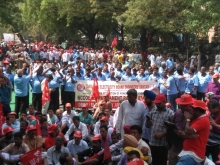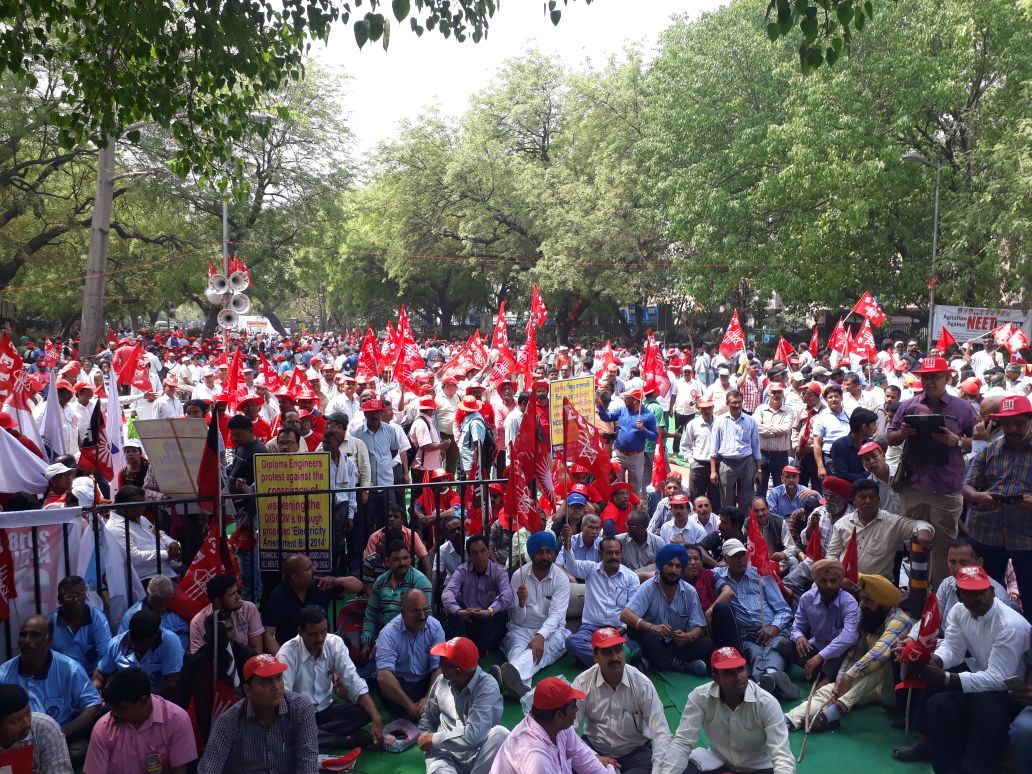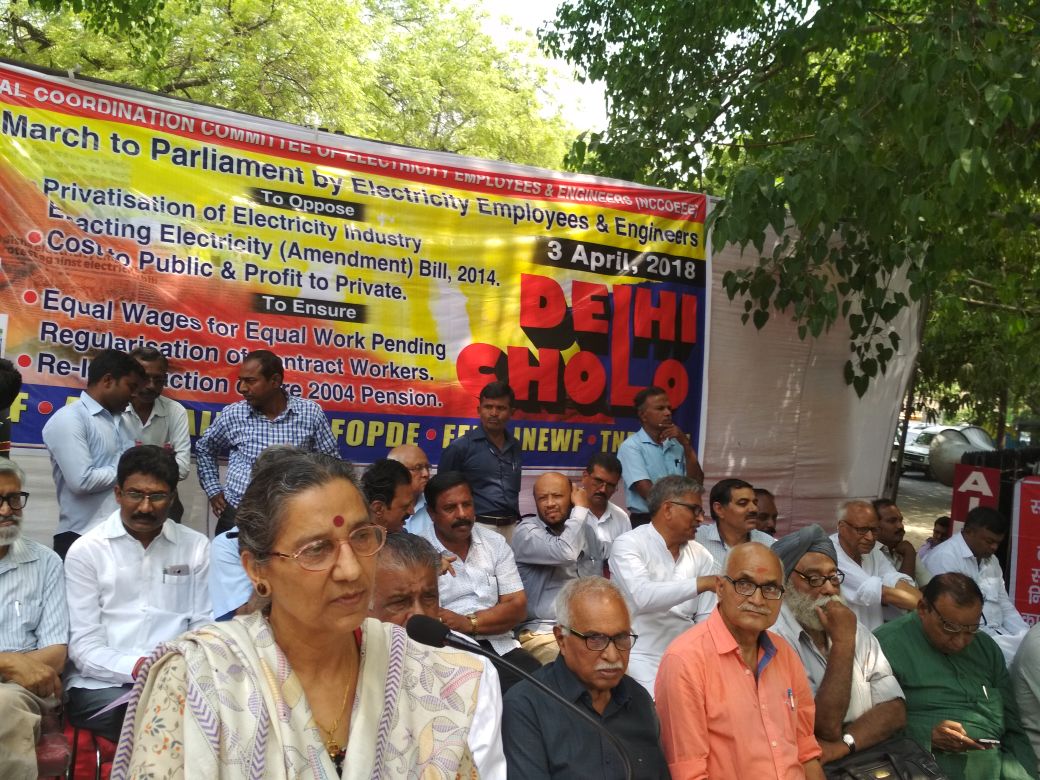Why are electricity workers and engineers opposing the electricity (amendment) bill 2014 in India?

By K. Ashok Rao, Patron, All India Power Engineers’ Federation
In 2003 there was not just an amendment of law but a complete conceptual and structural change as desired by the World Bank as part of the Structural Adjustment Conditionalities. Interestingly, the Electricity 2003 was similar to the Electricity Law No. 20/ 200 in Indonesia, The Constitutional Court of Indonesia annulled law, ruling that it was against the nation's Constitution for opening the door to full competition in the electricity business. The purpose of the change in legislation is to privatize a public utility. This was done by unbundling of generation, transmission and distribution – meaning making them all separate entities.
The BJP that is ideologically committed to market fundamentalism want to further the process of privatizing profits and nationalizing losses through the Electricity Amendment Bill 2014. The wires that bring the electricity to our homes are separated from the commercial aspects. That means one agency would bring the electricity to the home and another would sell the electricity and collect the payment. Multiple agencies would add to the cost, but it is justified on the ground that it will being in competition. However, competing firms will only compete for large and profitable consumers and small consumers are left out. The proposed legislation recognizes it and requires a Government owned licensee to take care of the loss making segment. Such a blatant pro private capital and pro rich policy will not only worsen the plight of the people and the crisis of the electricity sector, but also force the tax payer to bear the losses. That is the reason that the Electricity unions are strongly opposed to such measures, even though their voice does not find a place in the mainstream media.
 Since the Electricity Act 2003 has introduced private players the cost of the electricity has arisen significantly with the entry of the high cost private producers and distributers or the price rise has been held back as a regulatory asset to be liquidated through future price rise. Private sector entry has also resulted in reckless borrowing from the banks that cannot be repaid due to faulty planning resulting in stressed assets causing banks and term lending institutions like the Power Finance Corporation etc. having huge non-performing assets. The private sector generation companies have also indulged in over invoicing and importing equipment resulting in lack of orders for BHEL, that for the first time in 35 years reported losses.
Since the Electricity Act 2003 has introduced private players the cost of the electricity has arisen significantly with the entry of the high cost private producers and distributers or the price rise has been held back as a regulatory asset to be liquidated through future price rise. Private sector entry has also resulted in reckless borrowing from the banks that cannot be repaid due to faulty planning resulting in stressed assets causing banks and term lending institutions like the Power Finance Corporation etc. having huge non-performing assets. The private sector generation companies have also indulged in over invoicing and importing equipment resulting in lack of orders for BHEL, that for the first time in 35 years reported losses.
Not only is it important to put the proposed Electricity Act 2014 with a context, but to also familiarize readers with some basics of the Electrical power industry.
Basic facts about electricity
Electricity has to be consumed when it is generated almost instantaneously (since electricity travels at a speed of almost three lakh kilometers per second (299 792 458 m /s). That means that there can be no storage or finished goods inventory. Electricity has to be carried by wire up to the point of consumption.
There are three aspects – generation, transmission and distribution. All these were organizationally linked into one organization – State Electricity Boards (or in some places like Mumbai and Kolkata by private organizations). The law Electricity (Supply) Act 1948 was replaced by Electricity Act 2003 to unbundle and separate these functions in order to enable privatization. The Electricity supply industry was unbundled and several private sector players entered the industry thereby creating multiple agencies.
Movement of electricity has to be measured at every stage, electronically and through computers recording it to enable accounting. There are several stages at which the billing has to be done, How much the generator produced and gave to the transmission companies, how much was given to the distribution companies and how much to the supply licensees company and finally to the consumer will have to be measured and recorded. This will require fresh and large investment in metering and computerization thereby making electricity more complex since many states have large number of unmetered connections in agriculture and other segments. Large expenditure would also have been incurred on feeder separation schemes. Electricity is bound to be come costlier and unaffordable in a country where even today majority of the people do not have the purchasing capacity.
Cost and price of electricity changes continuously, since demand and supply change due to electricity having to be consumed when generated and vice-verse. Separate rates are charged depending on the time of consumption. This is called “time of day metering”. Many states have already implemented time of day metering for the big consumers. Sooner or later this will also be introduced for the household and agriculture sector. This means the cost of electricity would depend on the time at which it is used. Most residential consumers use electricity during peak hours which is the costliest.
What is the aim of the Electricity (Amendment) Bill 2014?
This present Bill further divides the unbundled electricity industry. The distribution sector is proposed to be split into wire and content. This means that like transmission, even distribution licensee will only deal with the physical flow of electricity and another organization – the supply licensee– will deal with the sale of electricity. The distribution company will carry electricity to the point of consumption (house hold, shop, factory or a tube-well). The final act of selling electricity to the consumer and collecting cash would be done by the selling company the supply licensee.
The Bill would enable, in any area, multiple licensees. The supply licensees could buy electricity from the distribution company or buy directly from the generating company (and pay wheeling – current carrying - charges to the transmission and distribution companies) and sell to final consumer at the best terms and rates. The objective of the Bill is that if you are a consumer, a household or a factory, many supply licensees will compete to provide electricity to you. In reality how many supply licensees would compete to sell electricity to a household, small establishment or a pump set? They would be interested only in large consumers.
The motive of the Bill is to separate profitable segments, like sale of electricity to industry, railways and commercial establishments, from the loss making segments, like rural households and pump sets. And then to hand over the profitable segments to the private sector, keeping the loss making segment in the public sector. The Bill institutionalizes this separation by stipulating that at least one of the supply licensees has to be a Government owned company.
More importantly, this creates a distinction between supply areas under publicly owned and privately owned distribution companies. In case of areas such as Mumbai, Delhi, Kolkata, Surat and Ahmedabad etc., which are currently under privately owned distribution licensees, the government will have to
proactively take up the responsibility of being the supply licensee for all the loss making areas. Invariably, the privately owned company may choose to keep the wires business and just be a subsequent supply licensee, which caters to only a certain select group of profitable consumers, thus absolved itself of universal supply obligation.
If there can be many service provides for mobile phones, why not for electricity?
 It is often argued that mobile phone has many service providers and a consumer can shift from one to another without changing the phone number. As a result the service has improved. Similarly, when there are several supply licensees who will compete, the consumer, will be the king.
It is often argued that mobile phone has many service providers and a consumer can shift from one to another without changing the phone number. As a result the service has improved. Similarly, when there are several supply licensees who will compete, the consumer, will be the king.
The fallacy in this argument is that mobile telephone is a wireless system, but electricity has to be a wired system. This physical difference changes the complexity and flexibility of operation as well as the investments required. But more than this, the basic distinction is that whereas in the mobile service the cost to serve is recovered and Ambani pays the same rate as a rickshaw puller. In the case of electricity most of the households and agricultural pump sets pay below the cost to serve and the service is provided at a loss. Loss making segment will become unsustainable and supply will be cut. In many countries like South Africa electricity was sold through meters that are charged to the extend you pay. So if you have paid certain amount and consumed that amount is 10 days instead of one month, the remaining 20 days you stay in darkness. This resulted in rioting. A large part of Indian population does not have the purchasing power and similar rioting would be inevitable.
PWC report for regulators bemoans that “tariffs that are not commensurate with costs of supply, and considerations of socio-economic & political sensitivity” Is it possible for a basic infrastructure, which today is a basic and essential necessity. not to be politically sensitive in a democratic system.
Can there be competition in shortages?
Competition is possible when there is surplus. In a shortage situation, only black marketing is possible, with competition in black marketing. Since the Bill separates the profit making and loss making segments, it would not be possible to ensure transparent and equitable distribution of shortages whenever power cuts are inevitable.
Government has been claiming that the days of surplus power has arrived. The Central Electricity Authority in its report has claimed that India was expected to become ‘power surplus’ in 2016-17. Data shows that the all-India ‘power deficit’ has gradually been easing. From 8.7 per cent in 2012-13, the shortfall fell to 2.1 per cent in 2015-16. This claim of surplus is based on existing number of consumers, whereas as many as 30 Crore (300 million) people across the country do not have access to power, that is one-fourth of population is without power. The number of persons without power will increase since power is increasingly becoming unaffordable.
The percentage of urban and rural households in Bihar without power connection stands at 33 per cent and 87 per cent, respectively. The corresponding figures for UP are 19 per cent and 71 per cent, respectively. The two states are trailed by Assam (16 per cent urban and 66 per cent rural), Jharkhand (12 per cent urban 63 per cent rural) and Odisha (17 per cent urban and 52 per cent rural) respectively. The other states include Meghalaya, Manipur and Madhya Pradesh.
Has multiple generators brought competition or increased the cost?
Before the amendment of the law and the introduction of private sector generation the Central Electricity Authority (CEA) used to exercise due diligence in regulating additions to thermal capacity so as to minimize
the backing down of thermal plants, thereby minimizing the need to back down1 Since the PPAs provide load guarantees, State Electricity Boards generating stations have to back down, thereby losing revenue.
Mr. EAS Sarma, former Secretary Power Govt. of India in a letter to CAG wrote, “The liberalised regime of 2003 discontinued such a regulatory oversight, opening the floodgates to proliferation of private thermal generation capacity across the States. Instead of assuming the risk of finding alternate consumers for the power generated by them, the private developers setting up thermal power plants took undue advantage of the over exuberance displayed by the States in inviting investments and forced them to sign PPAs with a deemed generation clause, thereby transferring the risk of finding an outlet for their power to the States. Power Purchase Agreements with private companies with a "deemed generation" clause that forces them to pay for the power they may not consume during the off-peak hours. The losses to the public exchequer on account of the “Deemed Generation” clause in the PPAs are mindboggling large. These are amounts that public sector utilities are forced to pay to private companies and indirectly, the huge cost burden is passed on either to the electricity consumers in the State”.
Enacting legislation without data and rules would ensure litigation.
Electricity (Amendment) Bill 2014 requires that existing PPAs will get transferred to an intermediary whose functions will be determined by the Govt. of India. Various states have signed PPAs with various terms and conditions, how the intermediary will ensure that all the conditions are met and at the same time generation is based on least cost principle; another gigantic problem will be assigning priority for the lowest cost generation to the supply licensee since all the licensees would want the cheapest power.
PWC report.for regulators states, “Due to unavailability of voltage wise data on cost and distribution losses, state regulators have to allocate costs and losses between the wheeling and retail distribution licensees’ functions on the basis of assumptions. Moreover, in the absence of proper data, cost of distribution licensees cannot be properly determined which affects the estimation of cross subsidy surcharge”
Lack of authentic data and lack of clarity regarding the functioning of the intermediate company and clear and unambiguous rules would be an open invitation to litigation. The existence of several organizations will ensure that disputes and litigations would multiply. Essentially, courts and lawyers will become the true regulators of electricity.
An overriding Constitutional question that needs to be answered: Is the Constitutional status of electricity as a concurrent subject being subverted by this central legislation? Since all PPAs would be administered by a central agency, it would become impossible for load dispatch centers to be managed by the state governments. There is bound to be legal disputes between central and state governments.
Where is the consumer awareness?
It is well established in economics that information asymmetry distorts competition. Unlike industrial buyers, householder or farmers have neither the information nor the skills to bargain terms to their advantage. The Electricity Act 2003 created independent regulators and power utilities have to file the
mandatory Annual Revenue Requirement (which contains relating to costs along with tariff proposals). The Act provides that any and every consumer could represent to the regulator and seek amendments to the ARR. But in actual practice how many farmers, householders or small traders or their representative associations have the ability to understand the contents of the ARR? Competition in a complex commodity like electricity is merely a theoretical concept for a majority of the consumers
Why the employees are opposing the legislation?
- It should be obvious from the above narrative that the motive behind the legislation is to privatize the profits and nationalize the losses.
- When the loss making sector is separated and handed over to the Government supply licensee, it would only add to the existing losses of more than Rs.3 lakh Crores.
- A point has already reached where the State can no longer bear the losses. The result would be imposition of supply cuts on sections of consumers such as farmers, small households, and small commercial establishments.
- There is little focus on supply and service quality issues, which are at the heart of consumers concerns
- Due to the preferential load guarantees given in PPAs signed with private generators, public owned power stations are compelled to back down and reduce or stop production resulting in revenue loss.
- Huge investments would have to be made in electronic metering and computer data logging in addition to and feeder separation, thereby adding to the cost. Electricity is systematically being made costlier.
- Electricity cannot be compared to mobile phones. Unlike in electricity, every user of mobile phone pays the same price which is above the cost tom serve. Consumer’s lack of knowledge of electricity negates competition.
- Legislation is being enacted without working out the details and setting the rules which will result in litigation. Since the Electricity Act 2003 there has been an exponential rise in litigation and private companies have earned more from litigation than generation.
- While State Electricity Boards were dismantled on grounds that integrated systems lead to inefficiencies, the three or four big private players like the TATA, Reliance, Adani etc. are doing just that building integrated systems. Private monopolies will replace public monopolies.
- State’s Government’s autonomy is being eroded and the Constitutional provision of electricity being a concurrent subject is being subverted with systematic centralization.
1 Electricity demand and supply licensees keep on varying during the day and seasons. Therefore, during off peak hours when the demand is low some of the generating units have to reduce their generation. This is known as backing down.
More information:

